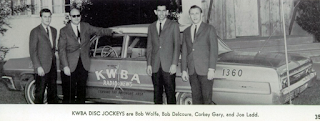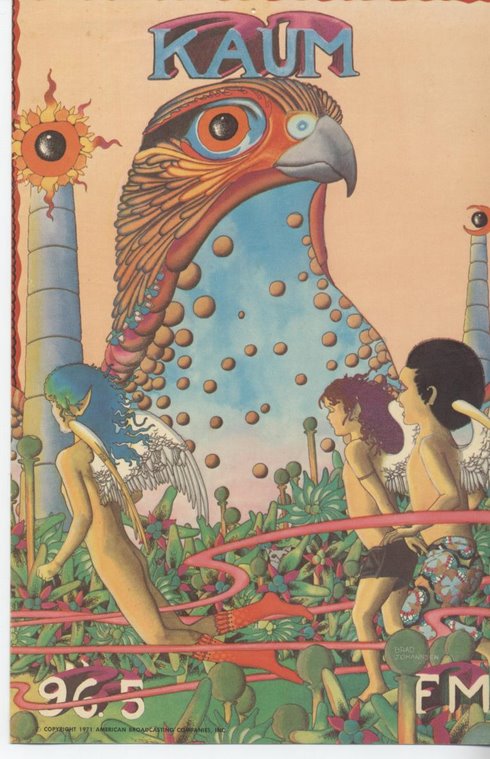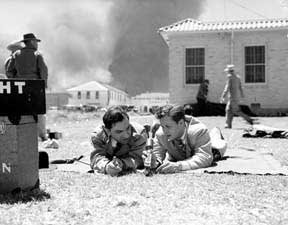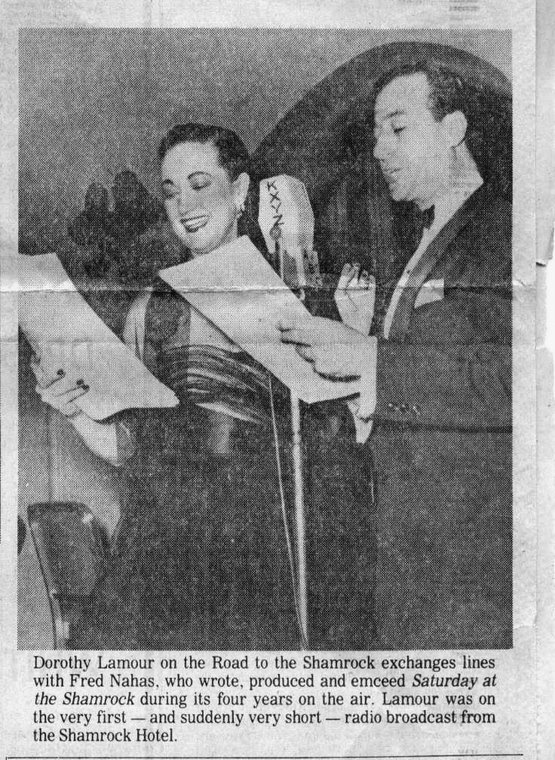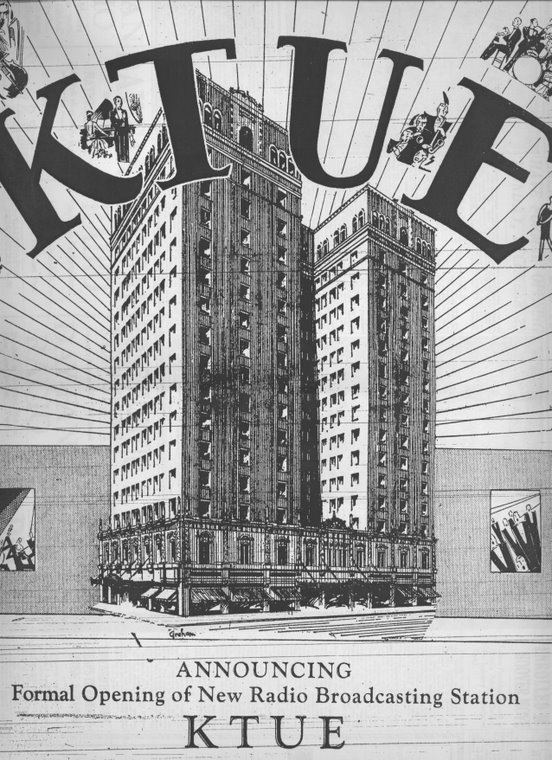1925 - KFVI and KPRC and a call for biscuits...
This post has been edited since it was first put on-line to include an image.
The year would turn out to be an eventful and important one in the history of radio in Houston. In January, 4 Houston area stations, including the two earliest, WEV and WCAK were struck from the Commerce Department lists; they were no longer in operation. The date was January 10. The other two which were deleted were WIAC, Galveston, and KFCV, Houston.
A license for KFVI was issued in March of 1925 to the 56th Cavalry Brigade, Headquarters Troop, to operate with 10 watts at 1210 kc. The station was to last a little over three years. Popularly known as the Cavalry Brigade, the 56th had been formed in 1919 and was actually a machine gun squadron and part of what we now know as the National Guard. It depended upon public donations for its existence and conducted annual fund raising drives.
Just what a National Guard unit needed a radio station for is not clear; perhaps it was seen as an aid to fund raising. Over a year earlier KFJZ, Fort Worth, had been licensed to the Texas National Guard, 112th Cavalry, so perhaps there was some common perceived need for communications capability. One of the people involved in putting KFVI on the air was William John Uhalt who claimed later to have put New Orleans station WCBE on the air before coming to Houston and would later start his own Houston station. (WCBE would later become WDSU; according to the WDSU-TV history, only the brother Joseph Uhalt is credited with putting WCBE on the air. Coincidentally, 2 people associated with WDSU would be among the original owners of Houston station KATL in 1947). Ted Hills was the program director and operator of KFVI; he would work at several other radio stations over the years including being the first program director of KTHT in 1944.
March of 1925 also saw WSAV deleted again from the Commerce Department list.
In April, WEAY moved to 1110 kc, but the most important event of the year concerned another new station authorized in Houston that year.
According to accounts published years later in the Post, sometime in the spring of 1925 Alfred P. Daniel became aware that Commerce Secretary Herbert Hoover was coming to a World Advertising Convention in Houston and was expected to make a major speech. Daniel wanted to broadcast that speech and he decided the time was right to approach Ross Sterling, Sr., about that 500 watt Westinghouse transmitter sitting in storage. Daniel must have been a pretty good salesman in addition to having notions about programming and knowing how to build radio equipment. Upon hearing Daniel’s arguments, Sterling relented and ordered the transmitter set up and in 3 weeks time, on Saturday, May 9, 1925, at 8pm, KPRC signed on with Alfred P. Daniel as its first announcer and program director. “Hello, folks, everywhere” were the first words spoken according to the official account.
The Post-Dispatch ran a front page story about the sign-on giving the line-up for all the dignitaries and entertainers that were to be on hand. They included three bands, one from Mexico City, one from St. Petersburg, FL, and the Humble Oil and Refining Co. Band from Baytown, the two former ones in town for the advertising convention. A regular nightly feature was to be a talk given by Houston Poet Laureat Judd Mortimer Lewis, a much loved entertainer of boys and girls. Incidentally, though May 9th is agreed upon by many sources as the start of KPRC, one source indicates the license was not issued until May 13.
The rival Houston Chronicle made no mention whatsoever of the new radio station. Both paper’s ‘Radio Listings’ included stations from as far away as New York City, Boston and all up and down the East and West Coast, as well as from such obscure places as Shenandoah, Indiana, and Billings, Montana, for the benefit of listeners who liked to ‘tickle their crystals’ and see what else they could listen to when the local stations were not on the air, but there were no regular listings of programming on Houston stations in the Chronicle.
The new station’s studios were located at the Post-Dispatch building on the southwest corner of Polk and Dowling which the newspaper had just occupied in March. Studios were located in the fourth floor morgue or library, a very cramped space. KPRC operated at 1010 kc (296.9 meters) with 500 watts and the paper claimed the signal could carry 9000 miles.
According to an article published in a 50th anniversary edition of the Houston Press (Scripps-Howard) on May 9, 1961, it was frequently advertised the call letters stood for Kotton Port, Rail Center. That was the phrase which led off the Post’s review of the opening broadcast in the edition of Sunday morning, May 10.
(Scripps-Howard) on May 9, 1961, it was frequently advertised the call letters stood for Kotton Port, Rail Center. That was the phrase which led off the Post’s review of the opening broadcast in the edition of Sunday morning, May 10.
The station had just 4 employees. The General Manager was G.E. Zimmerman, who had helped to put WRR and WFAA, Dallas, and KFDM, Beaumont, on the air before coming to Houston to help with KPRC. He was to work for KPRC for many years; in the early 1930s, he also served as GM of KPRC’s sister station, KTLC.
By 1926 the KPRC studios were relocated to the new 22 story Post-Dispatch ‘skyscraper’ on the southeast corner of Texas at Fannin which was for many years the home for Shell Oil Co. in Houston, before the present One Shell Plaza was built in the 1960s. The Post-Dispatch plant on Polk and Dowling has been demolished while the building on Texas has recently been renovated and opened as the Magnolia Hotel. By 1929, the KPRC transmitter (and license) was relocated to Sugar Land and in 1934 the studios moved to the Mezzanine of the Lamar Hotel where they stayed until moving onto Post Oak Rd. near the present Williams Tower in 1953. In the 30s, KPRC and KTRH shared a transmitter plant at Deep Water on the La Porte Highway.
The Commerce Department list of radio stations on the air that June, 1925, for Houston-Galveston included:
KPRC, 1010 kc, 500w
WEAY, 1110 kc, 500w
KFUL, Galveston, 1160 kc, 10w
WRAA, 1170 kc, 100w
KFVI, 1210 kc, 10w
WSAV, 1210 kc, 100w
KFLX, Galveston, 1250 kc, 10w
The WSAV license had been reissued earlier that month and the Post-Dispatch noted it was the station being installed at 1406 Houston Ave. on the near northwest side in Luna Park, Houston’s first amusement park. The story, however, gave the call letters as WFAV.
Although the official account claims the first words spoken on the new station were ‘Hello folks, everywhere,’ they actually may have been about biscuits. For months, years really, the Post ran stories daily summarizing the comments that had been received from far and near by telephone, telegraph, post card and letter about KPRC’s broadcasts. Usually these came under a headline, but sometimes they were just a few lines of filler in the newspaper. Messages were received in the first few weeks from as far away as Halifax, Nova Scotia, and Havana, Cuba, as well as all over the US. Six weeks after the launch, a woman in Navasota wrote the Post-Dispatch to say she had been up at 5:30 on the morning of May 9 with her receiver on when she heard some men talking about how they had been up all night working to get the station on the air and one said he could sure use a couple of biscuits. The paper neither confirmed nor denied such a conversation had taken place.
KPRC has long claimed to be the oldest Houston station still on the air and it is fully entitled to that claim. Although it cannot claim to be the first station on the air in Houston or the oldest in the Houston-Galveston market, its original owners were very much involved in broadcasting in Houston from the very first, in 1922. In addition to hiring the owner of one of the first stations on the air and supplying programming for the third station on the air they also sponsored programming on the first two stations on the air in Houston from the very first.
There will be much more about KPRC on this blog, including features on some of the early entertainers and performers.
Otherwise in 1925, WRAA, the Rice Institute station, was deleted for the last time in July, 1925, and the same thing happened to Clifford W. Vick’s WSAV in September. By the end of the year, KFYJ was licensed to the Houston Chronicle as a portable station. The license was issued in October and this was the second station licensed to the Chronicle in the early years. Portable licenses were good for only 120 days and were not renewable; they were like today’s remote trucks.
Meanwhile in Austin WCM was operating at 1120 kc with 250w in 1925, licensed to the Texas Markets and Warehouse Department. WCM had originally been licensed March 22, 1922, to the University of Texas, the first station in Austin and 2nd in the state of Texas. It had been deleted from the Commerce Department lists in June, 1924, then re-instated with the new ownership in November of that year. It was to be deleted for the last time in October, 1925, and that same month a new station licensed to UT with the calls KUT. In the years to follow KUT would play a role in the history of Houston radio station KTRH, Austin radio station KNOW, and San Antonio radio station KGDR.











